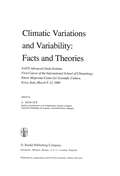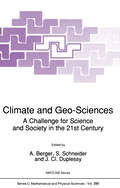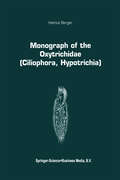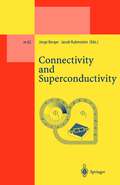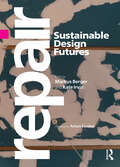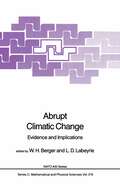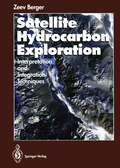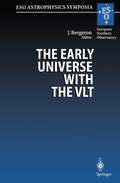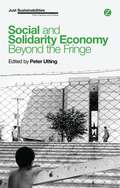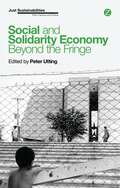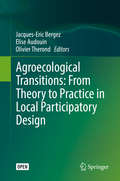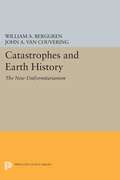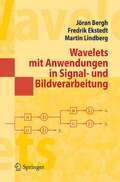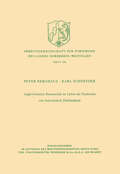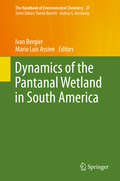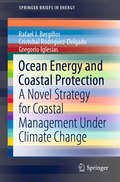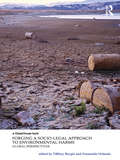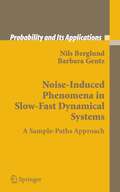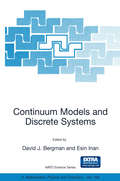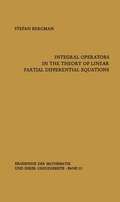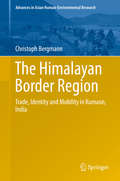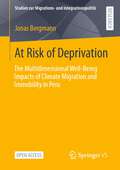- Table View
- List View
Climatic Variations and Variability: NATO Advanced Study Institute First Course of the International School of Climatology, Ettore Majorana Center for Scientific Culture, Erice, Italy, March 9–21, 1980 (Nato Science Series C: #72)
by A. L. BergerGENERAL INTRODUCTION TO THE ETTORE MAJORANA INTERNATIONAL SCHOOL OF CLIMATOLOGY The "Ettore Majorana Centre" for Scientific Culture, founded at Erice in 1963 by prof. Nino Zichichi, pursues the fundamental aim to create in Europe a cultural forum of high scientific standard, which can allow young research workers to appreciate current problems of major interest in the various fields of scientific research. , Since the beginning, its International Schools (over 70, today) have actively worked in disseminating scientific culture produced at the most advanced frontiers of human knowledge, spanning varied domains from biology to nuclear physics, earth sciences, meteorology, architecture, medical sciences and so on, Recently, in 1979, the International School of Climatology has been created with the purpose to organize post-doctorate cour ,;es, in which outstanding and up-to-date outlooks, theories and results in the climatic field must be presented in didactic form. Climatic variability was the subject of the first Course, in that climatic changes represent one of the most exciting phenomenologies to study; in fact, even if the climate has changed many times in the past, so making it reasonable to as sume that it will do so in the future, it is still not easy to understand the above mentioned changes from an hydrodynamical point of view.
Climate and Geo-Sciences: A Challenge for Science and Society in the 21st Century (Nato Science Series C: #285)
by A. L. Berger S. Schneider J. Cl. DuplessyIt has been widely recognized recently that in order to make scientific progress on large and important problems (eg, carbon dioxide effects on climate, viability of various sites for nuclear waste disposal etc.), it is necessary to integrate knowledge from wide ranging sets of disciplines. This is certainly true in the climate sciences, for progress in understanding the cause of the ice ages or the effects of industrial pollution on the future climate or even the likelihood of severe climatic consequences in the aftermath of nuclear war. All require state-of -the -art input from many geoscience disci plines climatology, oceanography, meteorology, chemistry, ecology, glaciology, geology, astronomy, space technology, computer technology, mathematics etc. Major international meetings have called for interaction of such geo-science disciplines to solve real world problems. To move beyond the rhetorical level, the NATO Special Programme on Global Transport Mechanisms in the Geo-Sciences whose activities started in 1983, deci ded to organise his closing symposium on such a topic which focus on the relationship between climate and geo-sciences. This symposium was held at the end of May 1988 at the Universite Catholique de Louvain, Louvain-Ia-Neuve, Belgium. One hundred-and-thirty participants from the 16 NATO countries and a number of non-NATO countries assembled for the Symposium. Another feature was the attendance by special invitation of 16 pro mising young scientists who might well become leading scientists on climate and geo-sciences in their respective countries in the next century.
Connectivity and Superconductivity (Lecture Notes in Physics Monographs #62)
by Jorge Berger Jacob RubinsteinThe motto of connectivity and superconductivity is that the solutions of the Ginzburg–Landau equations are qualitatively in?uenced by the topology of the boundaries. Special attention is given to the “zero set”,the set of the positions (usually known as “quantum vortices”) where the order parameter vanishes. The paradigm of connectivity and superconductivity is the Little– Parks e?ect,discussed in most textbooks on superconductivity. This volume is intended to serve as a reference book for graduate students and researchers in physics or mathematics interested in superconductivity, or in the Schr¨ odinger equation as a limiting case of the Ginzburg–Landau equations. The e?ects considered here usually become important in the regime where the coherence length is of the order of the dimensions of the sample. While in the Little–Parks days a lot of ingenuity was required to achieve this regime, present microelectronic techniques have transformed it into a routine. Mo- over,measurement and visualization techniques are developing at a pace which makes it reasonable to expect veri?cation of distributions,and not only of global properties. Activity in the ?eld has grown and diversi?ed substantially in recent years. We have therefore invited experts ranging from experimental and theoretical physicists to pure and applied mathematicians to contribute articles for this book. While the skeleton of the book deals with superconductivity,micron- works and generalizations of the Little–Parks situation,there are also articles which deal with applications of the Ginzburg–Landau formalism to several fundamental topics,such as quantum coherence,cosmology,and questions in materials science.
Repair: Sustainable Design Futures
by Markus Berger Kate IrvinA collection of timely new scholarship, Repair: Sustainable Design Futures investigates repair as a contemporary expression of empowerment, agency, and resistance to our unmaking of the world and the environment. Repair is an act, metaphor, and foundation for opening up a dialogue about design’s role in proposing radically different social, environmental, and economic futures. Thematically expansive and richly illustrated, with over 125 visuals, this volume features an international, interdisciplinary group of contributors from across the design spectrum whose voices and artwork speak to how we might address our broken social and physical worlds. Organized around reparative thinking and practices, the book includes 30 long and short chapters, photo essays, and interviews that focus on multiple responses to fractured systems, relationships, cities, architecture, objects, and more. Repair will encourage students, academics, researchers, and practitioners in art, design and architecture practice and theory, cultural studies, environment and sustainability, to discuss, engage, and rethink the act of repair and its impact on our society and environment.
Repair: Sustainable Design Futures
by Markus Berger Kate IrvinA collection of timely new scholarship, Repair: Sustainable Design Futures investigates repair as a contemporary expression of empowerment, agency, and resistance to our unmaking of the world and the environment. Repair is an act, metaphor, and foundation for opening up a dialogue about design’s role in proposing radically different social, environmental, and economic futures. Thematically expansive and richly illustrated, with over 125 visuals, this volume features an international, interdisciplinary group of contributors from across the design spectrum whose voices and artwork speak to how we might address our broken social and physical worlds. Organized around reparative thinking and practices, the book includes 30 long and short chapters, photo essays, and interviews that focus on multiple responses to fractured systems, relationships, cities, architecture, objects, and more. Repair will encourage students, academics, researchers, and practitioners in art, design and architecture practice and theory, cultural studies, environment and sustainability, to discuss, engage, and rethink the act of repair and its impact on our society and environment.
Abrupt Climatic Change: Evidence and Implications (Nato Science Series C: #216)
by W. H. Berger L. D. LabeyrieProceedings of the NATO Advanced Research Workshop, St. Hugues de Biviers, France, October 16-22, 1985
Satellite Hydrocarbon Exploration: Interpretation and Integration Techniques
by Zeev BergerOpening Remarks and spectral signatures which are manifested on satellite imagery data. The debut of satellite imaging systems on board This book aims to fill that gap. It is based on ex Landsat I in 1972 was a technological advance of perience gained in the past 14 years by me and considerable interest to earth scientists in general other members of the remote sensing and the and exploration geologists in particular. Two major structural analysis research groups at Exxon Pro uses were anticipated for the satellite data. First, it duction Research Company. Explorationists from was expected to replace the traditional aerial pho various Exxon affiliates which have used image tograph that had proven to be useful for mapping data to support hydrocarbon exploration have also geological structures, whether well exposed at the contributed. The examples used here, therefore, surface or obscured by thick vegetative and soil co are taken directly from Exxon's case studies and verage. In addition, it was predicted that the spec training material. The reader must bear in mind tral information provided by the imaging systems that some of the examples which are illustrated could be used to directly detect hydrocarbons from here have been modified to some extent for the sake space. of simplicity as well as for proprietary reasons.
The Early Universe with the VLT: Proceedings of the ESO Workshop Held at Garching, Germany, 1–4 April 1996 (ESO Astrophysics Symposia)
by Jacqueline BergeronThis is the second ESO workshop in aseries dedicated to science oppor tunities with the VLT. At the first workshop all areas of astronomical research were discussed. This second workshop is dedicated to research projects on the early Universe and has provided a forum for discussing strategies for studying faint distant objects in the optical and infrared spectral regions. This field is evolving very rapidly. There are several new surveys of galax ies and clusters of galaxies at intermediate redshift and quasars at very high redshift. Major advances in the morphological studies of distant galaxies, surveys of galaxies at high redshift and searches for primeval galaxies have been rendered possible by the new facilities provided by the Rubble Space Telescope and the Keck Telescope. Observational constraints on the evolution and formation of galaxies and large-scale structures as well as the cosmic chemical evolution were criti cally discussed with regard to theory and numerical simulations. In this context, the VLT first generation instrument capabilities were presented comprehensively and their use as cosmological tools discussed . The concluding remarks of the workshop focussed on the analysis of var ious possibilities for the VLT second generation instrumentation. Many of these topics were covered by invited reviews and talks, as well as some contributed talks. They are included in this volume together with the poster papers.
Social and Solidarity Economy: Beyond the Fringe (Just Sustainabilities)
by Suzanne Bergeron Stephen Healy Carina Millstone Bénédicte Fonteneau Georgina Gómez Marguerite Mendell Paul Nelson John-Justin McMurtry Cecilia Rossel Abhijit Ghosh Ananya Mukherjee-Reed Jean-Louis Laville Justine Nannyonjo Professor Bina Agarwal Béatrice Alain Cristina Grasseni Francesca Forno Silvana Signori Darryl Reed Roldan Muradian José Luis Coraggio Milford BatemanAs economic crises, growing inequality and climate change prompt a global debate on the meaning and trajectory of development, increasing attention is focusing on 'social and solidarity economy' as a distinctive approach to sustainable and rights-based development.While we are beginning to understand what social and solidarity economy is, what it promises and how it differs from 'business as usual', we know far less about whether it can really move beyond its fringe status in many countries and regions. Under what conditions can social and solidarity economy scale up and scale out - that is, expand in terms of the growth of social and solidarity economy organizations and enterprises, or spread horizontally within given territories?Bringing together leading researchers, blending theoretical and empirical analysis, and drawing on experiences and case studies from multiple countries and regions, this volume addresses these questions. In so doing, it aims to inform a broad constituency of development actors, including scholars, practitioners, activists and policy makers.
Social and Solidarity Economy: Beyond the Fringe (Just Sustainabilities)
by Suzanne Bergeron Stephen Healy Carina Millstone Bénédicte Fonteneau Georgina Gómez Marguerite Mendell Paul Nelson John-Justin McMurtry Cecilia Rossel Abhijit Ghosh Ananya Mukherjee-Reed Jean-Louis Laville Justine Nannyonjo Professor Bina Agarwal Béatrice Alain Cristina Grasseni Francesca Forno Silvana Signori Darryl Reed Roldan Muradian José Luis Coraggio Milford BatemanAs economic crises, growing inequality and climate change prompt a global debate on the meaning and trajectory of development, increasing attention is focusing on 'social and solidarity economy' as a distinctive approach to sustainable and rights-based development.While we are beginning to understand what social and solidarity economy is, what it promises and how it differs from 'business as usual', we know far less about whether it can really move beyond its fringe status in many countries and regions. Under what conditions can social and solidarity economy scale up and scale out - that is, expand in terms of the growth of social and solidarity economy organizations and enterprises, or spread horizontally within given territories?Bringing together leading researchers, blending theoretical and empirical analysis, and drawing on experiences and case studies from multiple countries and regions, this volume addresses these questions. In so doing, it aims to inform a broad constituency of development actors, including scholars, practitioners, activists and policy makers.
Conservation Behavior: Applying Behavioral Ecology To Wildlife Conservation And Management (PDF) (Conservation Biology Ser. #21)
by Oded Berger-Tal David SaltzConservation behavior assists the investigation of species endangerment associated with managing animals impacted by anthropogenic activities. It employs a theoretical framework that examines the mechanisms, development, function, and phylogeny of behavior variation in order to develop practical tools for preventing biodiversity loss and extinction. Developed from a symposium held at the International Congress on Conservation Biology in 2011, this is the first book to offer an in-depth, logical framework that identifies three vital areas for understanding conservation behavior: anthropogenic threats to wildlife, conservation and management protocols, and indicators of anthropogenic threats. Bridging the gap between behavioral ecology and conservation biology, this volume ascertains key links between the fields, explores the theoretical foundations of these linkages, and connects them to practical wildlife management tools and concise applicable advice. Adopting a clear and structured approach throughout, this book is a vital resource for graduate students, academic researchers, and wildlife managers.
Agroecological Transitions: From Theory To Practice In Local Participatory Design
by Jacques-Eric Bergez Elise Audouin Olivier TherondThis Open Access book presents feedback from the ‘Territorial Agroecological Transition in Action’- TATA-BOX research project, which was devoted to these specific issues. The multidisciplinary and multi-organisation research team steered a four-year action-research process in two territories of France. It also presents:i) the key dimensions to be considered when dealing with agroecological transition: diversity of agriculture models, management of uncertainties, polycentric governance, autonomies, and role of actors’ networks;ii) an operational and original participatory process and associated boundary tools to support local stakeholders in shifting from a shared diagnosis to a shared action plan for transition, and in so doing developing mutual understanding and involvement;iii) an analysis of the main effects of the methodology on research organisation and on stakeholders’ development and application;iv) critical analysis and foresights on the main outcomes of TATA-BOX, provided by external researchers.
Catastrophes and Earth History: The New Uniformitarianism (PDF)
by William A. Berggren John A. Van CouveringThis book, based on papers from a symposium at the Woods Hole Oceanographic Institution, shows the necessity of developing a new philosophy in place of the classical uniformitarianism based only on processes familiar in human experience.Originally published in 1984.The Princeton Legacy Library uses the latest print-on-demand technology to again make available previously out-of-print books from the distinguished backlist of Princeton University Press. These editions preserve the original texts of these important books while presenting them in durable paperback and hardcover editions. The goal of the Princeton Legacy Library is to vastly increase access to the rich scholarly heritage found in the thousands of books published by Princeton University Press since its founding in 1905.
Bioeconomic Modelling and Valuation of Exploited Marine Ecosystems (Economy & Environment #28)
by J.C.J.M. van Bergh J. Hoekstra R. Imeson P.A.L.D. Nunes A.T. de BlaeijThis book offers an environmental-economic analysis of exploited ecosystems with a clear policy orientation. The study moves beyond traditional economic fishery analysis in two respects. First, several theoretical and numerical models are offered that combine economic and ecological descriptions of fisheries. Second, valuation and stakeholder concerns are addressed in empirical analyses employing both qualitative and quantitative approaches. The approaches, models and policy insights are sufficiently general and innovative to interest a broad audience.
Wavelets mit Anwendungen in Signal- und Bildverarbeitung (Masterclass)
by Jöran Bergh Fredrik Ekstedt Martin LindbergGelungene Kombination aus Monografie und Handbuch: Sie spricht Leser an, die sich mit den grundlegenden mathematischen Ideen und Techniken der Wavelets vertraut machen und zugleich wissen möchten, wie die Theorie derzeit angewendet wird. Das Buch setzt Kenntnisse über Anwendungen der linearen Algebra, der Fourierreihen und Fourierschen Integrale voraus, weitere Kenntnisse sind ebenso wünschenswert. Eine allzu übertriebene Präzision würde jedoch zu hohe Anforderungen an die Leser stellen. Die Lösung des Dilemmas ist ein Kompromiss: Die Autoren verzichten auf einige mathematische Details und verweisen stattdessen auf weiterführende Literatur.
Anglo-friesische Runensolidi im Lichte des Neufundes von Schweindorf (Arbeitsgemeinschaft für Forschung des Landes Nordrhein-Westfalen #134)
by Peter BerghausDynamics of the Pantanal Wetland in South America (The Handbook of Environmental Chemistry #37)
by Ivan Bergier Mario Luis AssineThis book provides readers with in-depth insights into the changes in the Pantanal wetland from its formation to the actual and likely future states. It reveals that today’s Pantanal is an evolutionary consequence of geological, ecological and, more recently, man-made events taking place at distinct space-time intervals. Topics include geotectonics and sun-earth interactions, which largely dictate the rate of drastic changes that eventually disrupt ecological stability and radically rebuild the regional landscape. Furthermore, the biota-climate system is discussed as a major driver reshaping the ecohydrology functioning of the landscape on an intermediate timescale. Also covered are major changes in the landscape ecohydrology and biodiversity due to recent land-use and climate changes induced by humankind in the Anthropocene. The ability to recognize how those temporal scales impact the Pantanal wetland provides the opportunity for wise management approaches and the sustainable development of the region.
Ocean Energy and Coastal Protection: A Novel Strategy for Coastal Management Under Climate Change (SpringerBriefs in Energy)
by Rafael J. Bergillos Cristobal Rodriguez-Delgado Gregorio IglesiasThis book presents the innovative concept of the dual function of wave farms as both renewable energy generators and coastal protection elements against erosion and flooding. Developing renewable energy is one of the most pressing targets for society in the coming decades due to the finite nature of fossil fuels, their high costs, and the environmental impacts of their exploration and use, including climate change and the subsequent sea-level rise. Wave energy is one of the most promising renewable energy sources, thanks to its huge potential and low impact on the environment. As such, this book discusses the development and application of artificial intelligence to optimise wave farm location and layout, assesses the influence of the wave energy converter geometry on coastal protection against erosion and flooding, and analyses how the performance of wave farms as coastal defence elements is affected by climate change and sea level rise. The concepts, methods and conclusions presented are helpful to students, researchers, academics, engineers, designers, stakeholders and managers around the globe interested in wave energy, coastal engineering, and coastal management.
Forging a Socio-Legal Approach to Environmental Harms: Global Perspectives (Law, Justice and Ecology)
by Tiffany Bergin Emanuela OrlandoEnvironmental harms exert a significant toll and pose substantial economic costs on societies around the world. Although such harms have been studied from both legal and social science perspectives, these disciplinary-specific approaches are not, on their own, fully able to address the complexity of these environmental challenges. Many legal approaches, for example, are limited by their inattention to the motivations behind environmental offences, whereas many social science approaches are hindered by an insufficient grounding in current legislative frameworks. This edited collection constitutes a pioneering attempt to overcome these limitations by uniting legal and social science perspectives. Together, the book’s contributors forge an innovative socio-legal approach to more effectively respond to, and to prevent, environmental harms around the world. Integrating theoretical and empirical work, the book presents carefully selected illustrations of how legal and social science scholarship can be brought together to improve policies. The various chapters examine how a socio-legal approach can ultimately lead to a more comprehensive understanding of environmental harms, as well as to innovative and effective responses to such environmental offences.
Noise-Induced Phenomena in Slow-Fast Dynamical Systems: A Sample-Paths Approach (Probability and Its Applications)
by Nils Berglund Barbara GentzStochastic Differential Equations have become increasingly important in modelling complex systems in physics, chemistry, biology, climatology and other fields. This book examines and provides systems for practitioners to use, and provides a number of case studies to show how they can work in practice.
Continuum Models and Discrete Systems (NATO Science Series II: Mathematics, Physics and Chemistry #158)
by David J. Bergman Esin InanProceedings of the NATO ARW, Shoresh, Israel, from 30 June to 4 July 2003
Integral Operators in the Theory of Linear Partial Differential Equations (Ergebnisse der Mathematik und Ihrer Grenzgebiete. 1. Folge #N. F., 23)
by Stefan BergmanThe Himalayan Border Region: Trade, Identity and Mobility in Kumaon, India (Advances in Asian Human-Environmental Research #0)
by Christoph BergmannDrawing from extensive archival work and long-term ethnographic research, this book focuses on the so-called Bhotiyas, former trans-Himalayan traders and a Scheduled Tribe of India who reside in several high valleys of the Kumaon Himalaya. The area is located in the border triangle between India, the Tibet Autonomous Region (TAR, People’s Republic of China), and Nepal, where contestations over political boundaries have created multiple challenges as well as opportunities for local mountain communities. Based on an analytical framework that is grounded in and contributes to recent advances in the field of border studies, the author explores how the Bhotiyas have used their agency to develop a flourishing trans-Himalayan trade under British colonial influence; to assert an identity and win legal recognition as a tribal community in the political setup of independent India; and to innovate their pastoral mobility in the context of ongoing state and market reforms. By examining the Bhotiyas’ trade, identity and mobility this book shows how and why the Himalayan border region has evolved as an agentive site of political action for a variety of different actors.
At Risk of Deprivation: The Multidimensional Well-Being Impacts of Climate Migration and Immobility in Peru (Studien zur Migrations- und Integrationspolitik)
by Jonas BergmannThis open access book examines how and why various forms of climate (im)mobilities can impact people's objective and subjective well-being. Worsening climate impacts are forcing subsistence farmers worldwide to decide between staying or leaving their homes. This mixed methods study analyzes cases of climate-related migration, displacement, relocation, and immobility in Peru's coastal, highland, and rainforest regions. The results reveal that numerous farmers experienced profound and often negative well-being impacts, regardless of whether they stayed or migrated. The higher the structural constraints, such as weak governance, and the more damaging the climate impacts were, the higher the risk of well-being declines. Additionally, the affected individuals often had limited agency and ability to mitigate losses. These findings challenge the notion of "migration as adaptation" and emphasize the importance of safeguarding the human rights and security of those affected while addressing loss and damage. Without significant investments in such efforts, climate impacts could sharply diminish the well-being of numerous subsistence farmers worldwide—irrespective of whether they stay or migrate.
